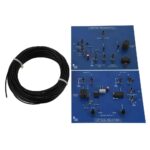This system enables the basic properties of optical fibres to be investigated and the ideas then extended to demonstration of some of the principal scientific and commercial uses. The low-cost plastic fibre may be cut to any desired length with a sharp knife and does not require any special terminating devices. It is also completely non hazardous. The system comprises a transmitter, a receiver (both built onto P.C. boards 120mm x 150mm) and a 25m length of optical fibre. 20m of this is intended for speed of light determination and long distance communication demonstrations.
Additional items required:
- Smoothed Power Supply Unit (College PSU or similar)
- Power Amplifier
- Loudspeaker
- Oscilloscope
- High Resistance Voltmeter
Technical Specifications:
Transmitter:
- Light source: High intensity red LED, output at 630nm.
- Modulation: Internal or external. The internal modulation source is a 300kHz oscillator (normally used for the speed of light experiment).
- External modulation input: 0 to 2V d.c. linear, up to 5V digital, or a.c. coupled via external capacitor (not supplied).
- External modulation frequency range: d.c. to greater than 300kHz, TTL compatible.
- Monitor output: 0 to 2.5V, for connection to an oscilloscope, or to measure the LED operating current.
- Power requirements: 5 to 6V smooth d.c., reverse polarity protected.
- Terminations, Optical: simple push in connection for 1mm diameter optical fibres.
- Terminations, Electrical: all connections by both 2mm and 4mm sockets.
Receiver:
- Input: Solid state photo-detector.
- Output 1: d.c. to greater than 5kHz, for connection to meters etc. and general analogue audio signals.
- Output 2: High speed digital output, 0 to 5V from below 20Hz to above 300kHz.
- Controls: Two, providing for zero-set and gain on output 1.
- Power requirements: 5 to 6V smooth d.c. reverse polarity protected, (the transmitter and receiver may share the same power supply if desired).
- Terminations, Optical: simple push-in connection for 1mm diameter optical fibres.
- Terminations, Electrical: all connections by both 2mm and 4mm sockets.
Top Tips
- Requires a Smoothed DC Power Supply.
- Both boards can be powered using the same Power Supply.
- Visualisation possible using an oscilloscope.












 Carpets & Mats
Carpets & Mats